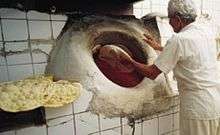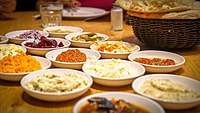Khubz
Khubz, alternatively spelled khoubz, khobez, khubez, or khubooz (Arabic: خبز, romanized: khubzun), also known as Arab(ic) bread, Lebanese bread, or Syrian bread,[1][2][3] is the generic word in Arabic for "bread," although often used in reference to a round leavened Middle Eastern flatbread, that forms a staple of the local diet from the Arabian Peninsula to Morocco. It originated in the Middle East.[3][4] It is used in many Mediterranean, Balkan, and Middle Eastern cuisines, and resembles other slightly leavened flatbreads such as Iranian nan-e barbari, Central and South Asian flatbreads (such as naan), and pizza base.
 Preparation of Khubz | |
| Type | Flatbread |
|---|---|
| Place of origin | Middle East |
Khubz was traditionally baked in a tannuur, and six recipes for khubz made in this way are included in Ibn Sayyar al-Warraq's 10th century Kitab al-Tabikh cookery book.
In Arab countries and also in Turkey, khubz is produced as a round flatbread, some 25 cm (10 in) in diameter. Since it does not contain any added fat, it dries rapidly and is best eaten while still warm from the oven. It has a somewhat tough chewy texture.[5]
The oldest known find of bread, by archaeologists in Northern Jordan, dates back 14,000 years. It was a sort of unleavened flatbread made with several types of wild cereals.[6]
As a result of the economic sanctions imposed on Iraq in the 1990s there was an increase in the making of khubz in the traditional way in a clay oven.[7]
Name
In Arabic, the names are simply خبز 'khubz, bread', الخبز العربي (al-khubz al-ʿarabiyy) 'Arab bread' or خبز الكماج 'al-kimaj bread'.[8]
In Egyptian Arabic, it is called ʿaish (عيش) or ʿaish baladi (عيش بلدي).[9] 'Aish means life in Arabic, highlighting the importance of pita bread in Egyptian culture.[9]
Culinary use
In Egyptian, Jordanian, Iraqi, Lebanese, Palestinian, Israeli and Syrian cuisine, almost every savory dish can be eaten in or on a khubz. Common fillings include falafel, lamb or chicken shawarma, kebab, omelettes such as shakshouka (eggs and tomatoes), hummus, and other mezes.
See also
References
- Wright, Clifford A. (2003). Little Foods of the Mediterranean: 500 Fabulous Recipes for Antipasti, Tapas, Hors D'Oeuvre, Meze, and More. p. 61.
- Serna-Saldivar, Sergio O. (2012). Cereal Grains: Laboratory Reference and Procedures Manual. p. 215.
- Stewart, Jean E. & Tamaki, Junko Alice (1992). Composition of foods: baked products : raw, processed, prepared. 8. United States Department of Agriculture, Nutrition Monitoring Division. p. 6.
Pita bread originated in the Middle East and is also known as Arabic, Syrian, and pocket bread.
CS1 maint: uses authors parameter (link) - Elasmar, Michael G. (2014). The Impact of International Television: A Paradigm Shift. p. 188.
- "Khubz. Arabic Bread". Al Mashriq (The Levant). Retrieved 2 October 2016. from Khayat, Marie Karam; Keatinge, Margaret Clark (1959). Food from the Arab World. Beirut: Khayat's.
- "Archaeologists find world's oldest bread and new evidence of sophisticated cooking dating back 14,000 years". The Independent. Retrieved 2018-07-17.
- Doug Smith (1 December 2007). "Iraqi bakeries make dough while they can". Los Angeles Times. Retrieved 15 March 2011.
- Cauvain, Stanley (2015). Technology of Breadmaking. New York: Springer. p. 232. ISBN 978-3-319-14687-4.
- Bard, Kathryn A. (2005). Encyclopedia of the Archaeology of Ancient Egypt. London: Routledge. p. 178. ISBN 978-1-134-66525-9.

